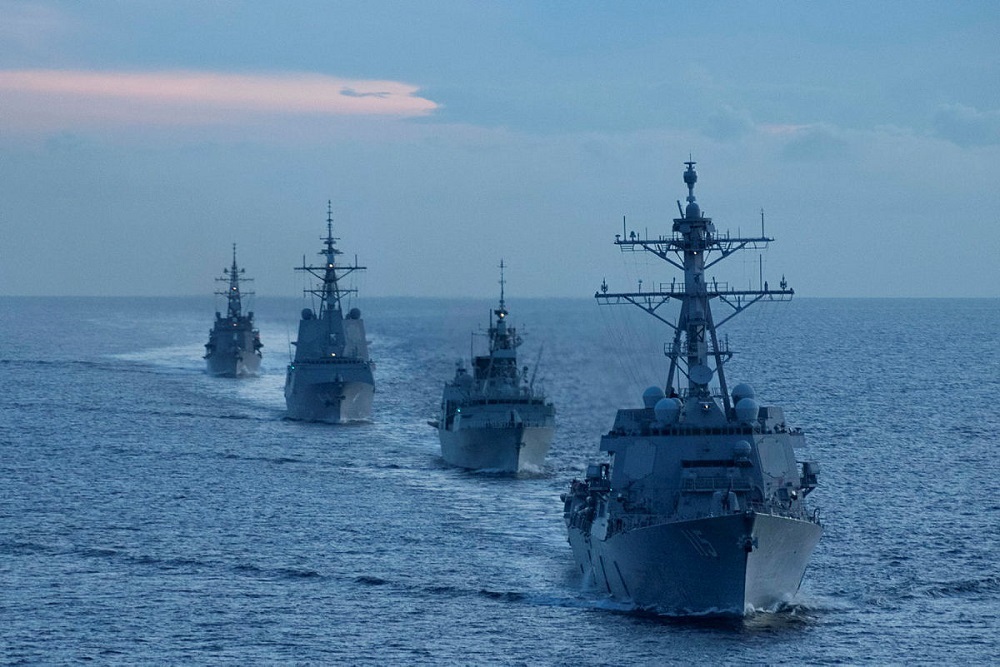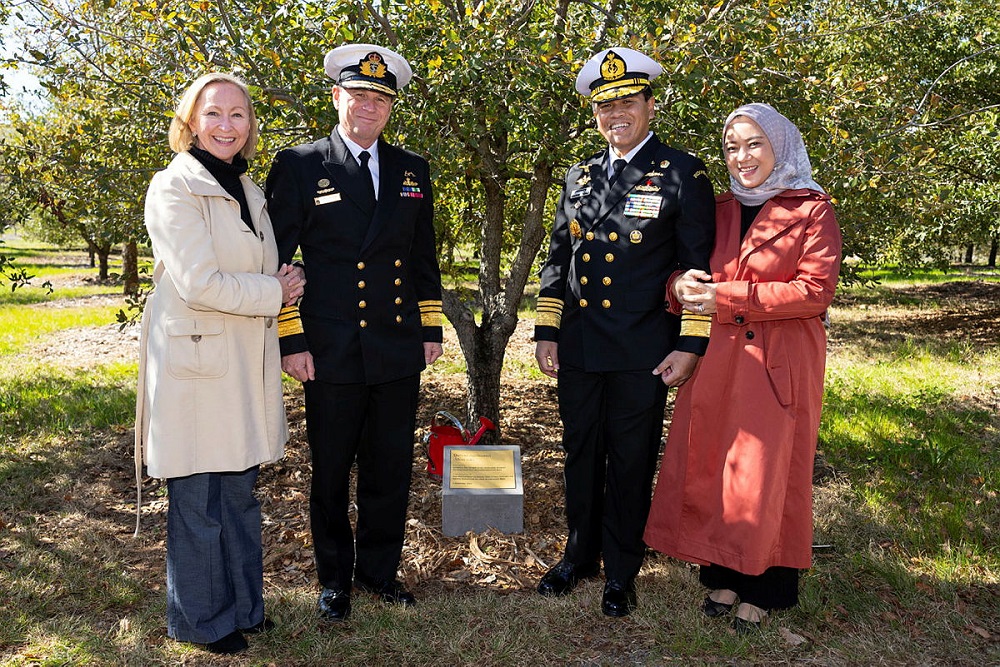
A year after being appointed chief of the Royal Australian Navy, Vice Admiral Mark Hammond admits to frustration when he’s asked why Australia needs a potent navy.
‘I wish that we were in a different intellectual space as a nation,’ Hammond says.
‘We’re a three-ocean island trading nation. We owe our economic prosperity to the sea. We’re custodians of the planet’s third largest exclusive economic zone. We have an annual import–export trade of about $900 billion per year that comes and goes by sea.’
All of that, says Hammond, relies on peaceful transit dependent on acceptance of and adherence to a rules-based order underpinning maritime trade and many other activities.
‘And most of the rest of our prosperity is derived from connectivity to the international financial system enabled by seabed cables, not by satellites. We have an absolute economic dependence upon the sea. We import nearly 80% of our liquid fuel with very low strategic reserves and limited refinery capability. Access to the sea is an existential issue.’
In a peaceful world it could be argued that trade will remain unmolested and prosperity will be assured by the international community behaving as predicted. But Russia’s invasion of Ukraine demonstrated violently that stability is not guaranteed.
‘We’ve seen a breakdown of diplomacy and deterrence and a disregard for international law,’ Hammond says.
‘If we cannot assume access to the sea, I firmly believe we should take steps to assure it. That means a very strong maritime capability, and in my lane, a very strong navy.’
At the age of 18, Hammond started his career as an electronics technician. He was appointed chief of navy in July 2022 shortly after the new government was elected in an increasingly difficult strategic environment. Since then, the defence strategic review (DSR) has handed down its recommendations, the surface fleet analysis is underway, the pathway to nuclear-powered submarines (SSNs) has been developed under the AUKUS agreement, and plans are in train to secure the workforce needed to make it all happen.
His strategic narrative focuses on diplomacy, deterrence and defence, codifying the RAN’s key missions under Defence’s ‘shape, deter, respond’ framework.
‘Our nation believes in solving problems through diplomacy,’ says Hammond. ‘We’re in a very challenging environment where some commentators say the risk of conflict is at its highest since World War II. We’re a peace-loving nation that would prefer to invest in diplomacy and deterrence and partnerships to avoid conflict in the first place. The navy exists to defend the nation.’
He says Australia’s interests and security can be advanced through naval diplomacy.
‘It’s an age-old responsibility and role of navies, and one that I think we’re particularly good at. Our nation has good convening power. Our navy is welcome in international ports, and we have extensive relationships across the Indo-Pacific and the globe which we develop and nurture,’ he says.
‘Those friendships should be leveraged to advance our diplomatic goals, and the Australian Defence Force’s deterrent effect. We’re a small force. There are many larger navies in the region and, where our interests and our values converge, we find many opportunities to work together.’
Most regional countries are island trading nations with histories and futures linked to the sea.
‘The navy leadership in the region recognises that,’ says Hammond. ‘Anything that changes the interpretation, for example, of coastal nations’ sovereign rights in their lawful exclusive economic zones has serious implications for a nation like ours.’
That starts with supporting the Department of Foreign Affairs and Trade’s mission: ‘On a port visit we offer a service to the head of mission to advance Australia’s national objectives and interests.’
Hammond says naval movements are nested within an international engagement strategy.
‘A small navy can’t be everywhere, so it’s important to prioritise visits, exercises, activities and operations that offer the best benefit to our government and people, and to our allies and partners,’ he says.
This includes partnering with nations where it’s important to them.
‘You’ve seen conversations around the Australian government’s engagement with the Philippines, for example. That has implications for navy deployment,’ Hammond says.
‘If you want to influence global conversations around the rules-based order, you’d better be present where it’s being discussed most acutely. In our case that means being present in the region, particularly in the South China Sea.
‘It also means being present where it matters to our southwest Pacific neighbours, helping them with fisheries surveillance and counter-drug operations, helping them grow their nascent maritime capabilities into something more robust so that they can enforce their sovereign claims and their EEZs to advance prosperity.’
Hammond says that also means sending visible signals about partnership, hence two Australian submarine visits to Indonesia in the past 12 months. An Australian Collins-class submarine and an Indonesian submarine have just sailed and exercised together for the first time.

Pictured (left to right): Jodi Hammond, Chief of Navy Vice Admiral Mark Hammond, Chief of Staff of the Indonesian Navy Admiral Muhammad Ali and Fera Djuara Matondang unveil a plaque during a tree dedication ceremony at the National Arboretum in Canberra, 1 September 2023. Image: Department of Defence.
‘We’ve also recently hosted the first visit by an Indian submarine. Deploying a submarine is a strategic decision, so when India chooses to send a submarine to Australia, it sends a serious and unprecedented message.’ The US commissioning a new warship, USS Canberra, in Australia symbolises the strength of the relationship between the two navies.
Defending Australia’s access to the sea depends on what it’s protected from and who we’re protecting it with, says Hammond.
‘That’s why we need an intellectual design around the integrated force that the DSR opines to maximise the efficiency and effectiveness of what we are doing, and a force focused on the areas that absolutely matter to our economic wellbeing and security.
‘We need to be clear that in the context of great-power competition we are not the central player – we’re one of the affected communities in the Indo-Pacific and we’re not seeking to stand alone. We’re part of an international community bound together by shared interests, shared values. We’re looking to leverage those aspects of diplomacy, partnerships and alliances to strengthen regional stability and our ability to protect our national interest.’
Hammond is a very experienced submariner well placed to oversee the introduction of SSNs. He has served on Australian boats going back to the Oberons, commanded a Collins-class submarine, and served on American, British and French nuclear submarines. He graduated from the US command course in 2003 and spent five months on Netherlands Walrus-class submarines. That included exercises with Royal Navy SSNs, some in Scottish lochs.
He says much has been done already to make the force more lethal and that’s accelerating after the DSR with the acquisition of sea mines, Tomahawk land strike missiles and naval strike missiles.
SSNs will bring a high-end ability to rapidly project power from the sea, he says. ‘Anyone seeking to do us harm would need to contend with that reality. As the government says, that puts a real question mark in an adversary’s mind.’ As well, submarines are very expensive for an adversary to counter.
Hammond doesn’t buy the theory that by the time Australia’s SSNs are operational, technological advances will have rendered the oceans transparent and submarines won’t survive. He’s been hearing it since he started on submarines as a lieutenant and says the claim is yet to be backed up by significant technological change.
With an oceanography degree, Hammond understands the opacity of the marine environment: ‘Variations in temperature, pressure with depth, and salinity complicate the movement of sound and light and we still principally rely on exploitation of sound and light through water to detect submarines.’
Submarines are quieter than ever, their sonars hear at greater ranges, nuclear-power technology is more advanced, and torpedos and submarine missile systems are more advanced.
There’s a contest between detection and counter-detection, between range advantage derived from acoustic advantage principally for submarines, and new detection theories some involving space-based capability and some involving quantum technology, he says.
‘The above-water environment is completely transparent, but nobody stopped building fighter aircraft, surface ships or missile systems,’ Hammond says.
The contest continues with stealth aircraft and ships trying to be more submarine-like in terms of their signature.
Hammond says the deterrent value of SSNs was demonstrated in the Falklands when a World War II torpedo from a Cold War submarine put the Argentine navy in port for the rest of the war: ‘Nobody wants to be sailing around in a surface ship when there’s a hostile submarine there.’
Since 1999, Australian submariners have taken part in the US submarine command course and in joint exercises. Many Australian commanding officers have ‘driven’ a nuclear fast-attack submarine. Over 100 US commanders have driven Australian submarines, often firing dummy torpedoes against US SSNs. Safety mechanisms prevent impact and the torpedoes are recovered and data analysed.
Hammond says it’s very different fighting a conventional submarine aggressively at 2 knots as the Australians practise, and driving an SSN aggressively at 20-odd knots. ‘Understanding how each other operates enhances the lethal potential of both submarine communities,’ he says.
Australia’s conventionally powered submarines cruise near the surface regularly, running their diesel engines via a snorkel to recharge the batteries of their electric motors. On the question of why the RAN shouldn’t continue to operate long-range conventionally powered submarines into the future, Hammond recalls that the Oberons, which Australia operated from the late 1960s to the 1990s, could cover thousands of nautical miles on the surface relatively undetected to get to areas far from home. By the time the Collins class replaced the Oberons, the advent of satellite technology and long-range radar meant the days of surface transits lasting weeks were over.
‘When I cast my eye to the 2030s and 2040s and beyond, I see a convergence of artificial intelligence, quantum computing and new above-water detection capability that’s going to render periscope operations more complex, more challenging and more lethal than ever,’ he says.
‘For the safety and the security of the next generation of Australians who will serve in the submarine force, I’m all in on trying to decouple them from that high-risk environment at periscope depth. That’s what nuclear propulsion allows you to do.
‘We’re not changing the nature of our operations. We are changing the propulsion system which enables those operations because it leads to a greater likelihood of mission success and a safer and more secure environment in a warfighting context than what we will be able to derive from a long-range conventional submarine.
‘With that you get all the benefits of extended endurance and extended range. You get more days at sea out of a nuclear submarine than you do out of a conventionally powered submarine. You get from A to B more quickly.’
It takes a Collins submarine 23 days to get from Sydney to the US base at Pearl Harbor. That’s after a 10-day trip from Perth to Sydney. ‘You’ve already put a month of wear and tear and 10,000-plus miles on your platform. And then you roll into an exercise which goes for four weeks.’
That’s followed by an extensive maintenance session before the submarine sails home or continues its operation. By comparison, an SSN can get from Sydney to Pearl Harbor in seven days.

